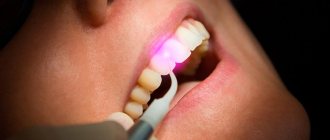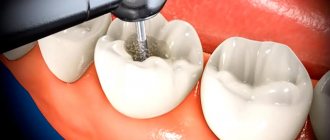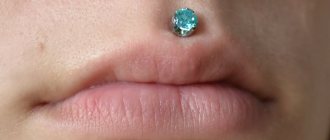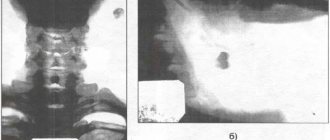How much can you not eat after having a filling installed?
All patients are interested in whether they can eat after having a filling installed.
You can eat food, but not immediately after the event, but after some time. Experts use various compositions, and each of them has its own hardening time. But first, you need to consider what you can’t eat after installing a filling in order to avoid its premature destruction.
The list of prohibited products includes all solid products, including chips and crackers, viscous - toffee and other products of similar consistency, coloring - coffee and tea, tomatoes, beets and the like. The consumption of hard and viscous products contributes to the destruction of the filling, and the use of coloring products causes a change in the color of the filling material.
Temporary restrictions
The first question that patients ask the doctor after treatment is: how long can you not eat? It all depends on the technology used, and some of them allow you to eat food almost immediately.
But there is one caveat. Even if the top layer has already hardened, the inner layer is subject to deformation. Therefore, there is no need to rush. There are the following general recommendations on time limits (according to the type of material):
- amalgam – 3 hours;
- plastic – from 3 to 5 hours;
- cement - from 2 to 3 hours;
- photocurable composites – can be eaten immediately;
- chemically cured composites – 1 hour;
- temporary fillings except photopolymer ones – from 2 to 3 hours;
- photopolymer temporary fillings – no restrictions.
Is it possible to drink after having a filling installed?
At the appointment, patients always ask whether they can drink tea or other drinks after treatment. In this case, the same recommendations apply as for eating - it all depends on the technology. But there are also additional restrictions. Drinking drinks is not recommended until the anesthesia effect has completely subsided.
This is due to the possibility of injury to the mucous membrane by too hot a liquid, because sensitivity is reduced. It is very difficult to say exactly how long you can drink. In this case, everything depends on the effectiveness of the painkiller, its duration of action, dosage and individual reaction of the body.
Why does a tooth hurt after a filling with arsenic?
When using arsenic paste to treat dental problems, many patients hope for instant results. However, the therapeutic effect increases gradually. Sometimes it takes up to 3 days for complete necrosis. As a result of all manipulations, the doctor should obtain a completely devitalized pulp. There should be no nerve bundles left in it, which cause pain. After this, the dentist will have the opportunity to calmly remove soft tissue and fill the tooth.
For some time after using arsenic paste, the tooth may continue to bother you. You can relieve pain at home with medication. The drugs of choice are usually Ketanov, Ketorol and Nurofen.
Rinsing is considered a safe method of eliminating pain. The procedure has a mild anti-inflammatory effect and soothes soft tissues. As ingredients, you can use a soda solution, a decoction of chamomile and calendula, or an infusion of wormwood. To prepare them, pour a glass of boiling water over a small amount of dry raw material and wait a few minutes. Then you can either rinse your mouth with the infusion or apply a cotton pad soaked in it to the affected area.
In case of severe pain, the following procedures are strictly contraindicated:
- take painkillers in large dosages;
- apply warm compresses to the affected area;
- while eating, artificially create increased mechanical loads on the diseased tooth.
You should be especially careful when taking analgesics. Otherwise, the clinical picture will be blurred and the moment when the normal process of devitalization turns into a pathological one will be missed. If the toothache does not disappear, intensifies and causes severe discomfort, you should consult a doctor again. Such symptoms indicate the development of complications, the most unpleasant of which is sepsis.
Main causes of pain
After using arsenic paste, some patients complain of unbearable pain. It cannot be tolerated for long, because the consequences may be unpredictable. Prolonged pain syndrome can occur for the following reasons:
- incorrect dosage of the substance;
- an advanced pathological process, when arsenic is simply powerless (for example, in the case of periodontitis, phlegmon or abscess);
- improper treatment of pulp with arsenic (use of an overly dense filling);
- allergy to arsenic and other components of the composition, which manifests itself in the form of pain;
- progressive periodontitis, which is additionally manifested by increased temperature and swelling of the gum tissue;
- necrosis of the periosteum;
- swelling of the gums;
- aggressive effect of the composition on dental tissues;
- non-compliance with filling technology;
- spread of inflammation to adjacent healthy areas.
Only a dentist can determine the exact cause of the ailment. Therefore, you cannot delay your visit to him.
Other symptoms that should be a cause for concern are presented in the table below.
| Clinical symptom | Cause of the complication | What to do to eliminate it |
| Edema | This symptom is a manifestation of an allergic reaction to the components of the paste. In particularly serious cases, uncontrollable shortness of breath develops. | It is necessary to take any antihistamine. The dosage is calculated strictly according to the instructions that come with the drug. It should not be exceeded in order to enhance the therapeutic effect. After the condition improves, you need to contact your dentist and remove the arsenic paste. |
| Redness of the gums | Paste particles got into neighboring healthy areas. | You need to contact your dentist to have the excess drug removed. |
| Black enamel | This is evidence of penetration of arsenic paste onto tooth enamel. If you don't clean it in a timely manner, they can take hold forever. | The dentist must quickly remove excess drug and apply a special product to the enamel to restore the natural shade of tooth enamel. |
| Weakness, poor health | Dyspeptic disorders, drowsiness, general weakness and malaise are all clear signs of intoxication of the body. The patient requires urgent medical attention. | The doctor must urgently remove the arsenic paste from the canal. Then the patient is prescribed absorbents to relieve intoxication syndrome. If necessary, symptomatic therapy is additionally used. |
When using arsenic paste, it is necessary to correctly calculate the dosage of the composition. Otherwise, patients with individual hypersensitivity to its components will exhibit all the symptoms of intoxication. Some patients are afraid to disturb the doctor once again and do not seek medical help. This approach is unacceptable, because carelessness can cost the health of an entire tooth, and sometimes even a person’s life.
Recommendations
Immediately after installation, you must refrain from drinking and eating for the time recommended by the dentist until the final effect of the pain medication. After this period, you should not eat foods that are too hot or too cold, as they may affect the strength properties of the material.
The load should be moderate. It is advisable to try not to chew on this side of the jaw during the day, since the filling may become loose if it does not harden sufficiently.
In addition to traditional questions about food and drink, dental visitors are also interested in additional questions.
Is it possible to drink alcohol
In fact, alcohol does not have any special effect, which means that theoretically it can be consumed. But the point here is completely different. In most cases, filling is performed under anesthesia, and it and alcohol are incompatible. Therefore, experts recommend abstaining from alcohol for at least a day.
The same can be answered to the question “can I drink beer?” After 24 hours, yes, you can. Beer does not contain coloring enzymes and fillings do not change color under its influence.
Is it possible to smoke after installation?
After the filling procedure, you can smoke approximately 2-3 hours later.
. Tobacco smoke does not affect the color of the filling, unless it concerns plastic-based compounds. They are rarely used due to their fragility, but when using such a composition, smoking immediately after the procedure will cause its darkening. Ideally, dentists recommend giving up cigarettes for at least a day, if possible.
Contraindications for depulpation
When is it impossible to remove a dental nerve?
- stomatitis, inflammatory, purulent processes in the oral cavity;
- cardiovascular diseases;
- ARVI, sore throat, influenza;
- infectious hepatitis;
- hemorrhagic diathesis;
- acute leukemia;
- psychoemotional disorders;
- pregnancy.
Depulpation methods. How is the dental nerve removed?
Vital method
The vital depulpation method is used in adults and children - for all forms of pulpitis. This is a one-session procedure performed under local anesthesia. The dentist prepares the tooth, removes the pulp, cleans and fills the root canals, and then places a filling.
Devital method
The devital depulpation method is used to completely remove the coronal and root parts of the pulp. It differs from the vital method in the duration of treatment. An arsenic-free paste is applied to the pulp, after which a temporary filling is installed. The permanent filling is installed at your next visit to the dentist. In modern clinics, this method of treatment is used less and less.
Regardless of the method, the depulpation procedure is always carried out under anesthesia and the use of x-ray control of the tooth before and after depulpation. In 99% of cases, the vital method is used, in which complete, painless dental treatment can be completed in just one visit to the doctor.
From the history of depulpation or how were dental nerves removed before?
Depulping with arsenic is an outdated, quite painful and time-consuming method. The essence of depulpation with arsenic is that the dentist, using a dental drill, expands the root canal of the diseased tooth, opening direct access to the pulp. Then arsenic is placed in the canal and the tooth is covered with a temporary filling. Within a few days, arsenic affects the pulp, causing its death. A few days later, the patient visits the dentist again, who removes the temporary filling and removes the dead nerve from the canal. Then the dentist cleans the root canal and places a permanent filling. If the tooth continues to hurt after removing the nerve, the nerve may not have been completely removed. If pain after depulpation is caused by improper treatment and/or poor-quality canal treatment, the patient needs to visit the dentist again.
One of the main disadvantages of depulping with arsenic is its unsafety. With prolonged contact with a tooth, arsenic can lead to its complete destruction, because Arsenic is a poison, so arsenic paste was applied for a short period of time.
In modern dentistry, preference is given to safer methods of pulp removal.
Features of depulpation
Features of depulpation of baby teeth
It happens that pulpitis develops on baby teeth in children. In children, the depulpation procedure has its own characteristics:
- The minimum dosage of anesthesia is safe for the child;
- Careful opening of the crown;
- The most careful removal of the nerve ending, so as not to damage the primary processes of the molars;
- Thorough disinfection after depulpation to avoid re-inflammation;
- A filling for a baby tooth (based on mummifying compounds) – gives a disinfecting effect.
Depulpation of wisdom teeth
The difficulty of removing nerves from wisdom teeth lies in the inaccessibility of the teeth and the complexity of the structure of their canals. Therefore, if inflammatory processes occur in the pulp of wisdom teeth, it is better to remove the wisdom teeth.
Possible complications of depulpation
Complications that may arise after depulpation appear for 2 reasons:
- Anatomical features of dental canals and pulp.
- Incorrectly performed depulpation procedure.
Anatomical features of dental canals and pulp
Often the dental canals are very curved, in such cases access to the pulp can be difficult and it is difficult for the dentist to reach the nerve. In this regard, the pulp may not be completely removed, or cavities may remain in the canals.
The use of X-rays allows us to study the shape of the canals before removing the nerve and select the most appropriate instruments, which minimizes the likelihood of the above-mentioned treatment complications.
Incorrectly performed depulpation procedure
- Careless cleaning of the canals will preserve and intensify the inflammatory process due to incomplete removal of damaged tissue.
- Using an inappropriate pulp extractor channel size or improper handling of the instrument.
- Broken dental instrument, retention of its remains in the dental canal (this error may lead to the need to remove the tooth).
- Residual pulpitis occurs against the background of incompletely removed pulp.
- Perforation of root walls;
- Allergic reaction to filling material.
Poor disinfection of the canal when removing the nerve can trigger the process of suppuration. Which, in the absence of adequate treatment, can develop into a periodontal abscess. Such a complication leads to the need for tooth extraction.
Other possible complications:
Painful sensations for several days after depulpation - the duration is individual for everyone. If pain persists for a long time, it is necessary to consult a doctor to re-open the canals and carry out disinfection.
Specific problems can arise if the material is applied incorrectly: if the filling extends beyond the boundaries of the root apex, the jaw nerve may be pinched.
Recommendations
Recommendations after depulpation:
- refuse, for at least 2 hours, increased physical activity;
- rinse your mouth with antiseptics prescribed by your doctor during the day;
- hold off on eating for the first 3 hours (drink boiled, warm water through a straw);
- give up smoking and alcohol for five days, also do not take (solid, hot/cold, spicy) foods that cause irritation of the mucous membrane;
- It is forbidden to drink cold drinks, ice cream, or apply ice to the affected area.
Prevention recommendations:
Regular teeth cleaning combined with systematic visits to the dental clinic is the best way to save yourself from the need to undergo a nerve removal procedure. A visit to the dentist once every six months will ensure timely treatment of caries and will not allow the carious process to penetrate too deeply into the tooth tissue and spread to the pulp.
Remember! There are no folk remedies for removing the dental nerve! Even if it is possible to “kill” the nerve, pulp removal is only possible by a qualified dentist using special instruments!
Number of views 3,328
We also recommend:
Tooth cyst - symptoms, treatment
Chewing gum: good or bad for teeth?
What not to do after installation
The main thing that should not be done after installation is to subject the tooth to increased loads.
. Therefore, gnawing any foods (nuts, seeds, candies, etc.) is highly discouraged. Avoid the use of chewing gum, toffees and other similar confectionery products that tend to stick to teeth.
The consumption of hot and cold foods is limited; this can cause the filling material to break prematurely.
There should be no traumatic impact on the tooth, therefore, if discomfort is felt, you should consult a doctor and not take any action yourself.
Is it possible to brush your teeth
A specialist will definitely advise you on how to brush your teeth after installing a filling. It is advisable to do this only the next day. In some cases, it is recommended to change the paste and brush. It is better to choose a brush of medium softness; it will not injure the injection site. Pastes - on the recommendation of a doctor, but without the inclusion of abrasive components.
Recommendations after installing a light seal
Photopolymer is a new material that instantly hardens under the influence of a solar lamp.
Has high strength characteristics. It is possible to select a shade that best matches the natural one. After installation, such a filling is not visible even on the front teeth.
Care
Caring for teeth with polymer fillings is not particularly difficult:
- they need to be cleaned regularly, with a medium-hard brush and gel toothpastes that do not contain abrasive inclusions;
- Dental floss should be used carefully; if it clings to the edge of the filling, you should immediately contact a specialist to eliminate this defect;
- exclude coloring foods from your diet for at least a week;
- limit the consumption of sweets, including sweet carbonated waters, especially those with dyes;
- For several days after the event, do not load the tooth and limit yourself to solid food.
Is it possible to eat after having a light filling installed?
The photopolymer hardens instantly, but the inner layer does not have sufficient strength for some time. Therefore, a reasonable question arises: “when can you eat?”
Although many doctors allow you to eat food immediately after the event, it is better to refrain from eating for a couple of hours. There is a risk of material deformation.
There is also the possibility of staining, so you need to consider what not to eat.
Foods that can stain the filling are completely excluded from the diet for 7 days. These are any drinks with dyes, including strong tea and coffee. Fruits and berries with a likelihood of such an impact (cherries, sweet cherries, mulberries, blackberries, raspberries, black currants and the like). Vegetables such as carrots and beets. It is worth giving up tomato-based ketchups and sauces, tomatoes themselves in any form, and a number of juices. Dentists recommend following a “white” diet during this period. That is, eat only what cannot stain the filling.
Recommendations after installing arsenic paste
During the first two hours after dental procedures, you should not eat or drink. The seal should set and provide a tight seal. Arsenic should not come into contact with surrounding tissues other than the nerve. If you neglect this rule, the seal may be damaged. As a result, the paste will enter the gastrointestinal tract.
Doctors do not rule out slight penetration of the drug with arsenic into the mouth. In this case, patients note the appearance of a sour taste. To neutralize it, you can make baths with soda. This is a fairly simple procedure that helps protect the mucous membranes from possible burns.
A paste containing arsenic is absolutely harmless if the doctor used it in the correct dosage. It is even used in dental treatment for children.
If you suspect that the paste or a small part of it has fallen out, you must contact your dentist again. However, at home you can neutralize its harmful effects. To do this, just drink a few cups of milk. The liquid removes poisons and toxins from the body well.
It is not advisable to wear a temporary filling for more than 3 days. If the damaged tooth has only one root, the paste should be kept for a day. If there are 2 or more roots, this period is extended to 2 days.
A temporary filling can remain on the tooth for up to 6 months. If for some reason the patient cannot go to the dentist to complete treatment, the components of the composition will penetrate into adjacent departments. This is dangerous due to subsequent damage to nearby teeth.
The maximum period for using arsenic-based paste is 1 week. Even in the absence of severe pain, neglecting a visit to the doctor is unacceptable.
Quite often, patients note that after applying a temporary filling, pain does not disappear. There is no reason to immediately run to the dentist. Each person’s body is individual and reacts differently to treatment. Arsenic slowly kills part of the tooth. Don't expect instant results.
After installing a temporary filling
A temporary filling is necessary for multi-stage treatment, which involves access to the cavity after several days or weeks. Therefore, the strength and aesthetic requirements for such materials are low. But in any case, you must adhere to the specialist’s recommendations, otherwise the filling will fall out, pathogenic microbes will enter the cavity and the procedure will have to be repeated.
After installation of a temporary filling, patients are interested in the ability to eat and drink. These points need to be considered.
Is it possible to drink
If a regular cement filling was used, you can drink after 2-3 hours. If the cavity is closed with photopolymer, immediately after installation is completed. But the point here is not about strength, but more about anesthesia. When exposed to it, sensitivity is minimal, so the patient may not feel the temperature of the drink and injure the mucous membrane. Therefore, you need to drink very carefully, avoid too cold or too hot, and it is better to do this after the painkiller has worn off.
Is it possible to eat
The specialist’s answer depends on the material
. The use of a cement filling involves the same restriction as in drinking: from 2 to 3 hours. With photopolymer, it is absent, but it is not recommended to load the tooth until it has completely hardened, so you will have to abstain from hard foods for at least a day.
Removal of tooth nerve with arsenic
Removing pulp using arsenic is considered an outdated treatment method, which is almost never used today. The procedure was quite simple: the tooth was prepared using a drill, then the root canals were expanded, medicine was applied to remove the nerve in the tooth, after which a temporary filling was installed for 2 - 3 days. The negative side of such treatment is that arsenic is a strong poison that has a detrimental effect on both the tooth and the tissues surrounding it. With the advent of new safe techniques, the need for arsenic has disappeared.
Is it possible to experience discomfort after treatment?
After the procedure, slight discomfort is present for 14 days - this is normal.
. During this period, it is necessary to eliminate as much as possible the influence of factors that provoke unpleasant sensations - hot and cold foods, sour, spicy and sweet foods. You also need to avoid excessive stress and carry out hygiene procedures with caution.
But if pain occurs after this period has expired, this is a reason to consult a doctor. There are many reasons for this phenomenon, and only a specialist can accurately identify a specific one.
What to do if your tooth becomes sensitive after installing a filling?
If after installation the tooth reacts to cold or hot, but the required 2 weeks have already passed, you need to urgently go to the dentist. The exception is recently treated pulpitis. In this case, increased sensitivity persists for up to a month.
The specialist will conduct a diagnosis and determine the cause of this phenomenon. This could be the consequences of poor quality filling installation, inflammation or similar diseases. The most common cause of pain is the occurrence of repeated caries. In this case, the destruction of the enamel continues.
What causes recurrent caries
Repeated carious lesions of tooth tissue can occur due to non-compliance with technology,
which happens rarely, or
the patient’s failure to comply with the doctor’s recommendations – which happens often
.
Due to the shrinkage of the material, which is caused by increased load on the tooth, microcracks appear between the filling and the tissue. They contain pathogenic bacteria. When they multiply, they form an acidic environment. All this contributes to the occurrence of repeated caries, which is hidden under the filling and is diagnosed only after the active development of the pathology. Therefore, it is very important not to violate the doctor’s recommendations. Also, incorrect actions can cause the filling to fall out.
Indications and contraindications for the use of arsenic
Arsenic acid is used for devitalization, that is, killing the dental pulp in order to then partially or completely remove it. Before the development of anesthesia, this was the only way in which it was possible to remove a tooth relatively painlessly, cure pulpitis and some other dental diseases.
Now the pulp is removed under local anesthesia and using drugs without arsenic. But there are indications according to which he is still placed. These include:
- Acute diffuse or chronic fibrous pulpitis;
- Chronic hypertrophic pulpitis in teeth with impassable and curved canals;
- Allergy to local anesthetics;
- Severe general condition, for example, after a heart attack or stroke;
- Inability to open the mouth wide due to contraction of the lower jaw.
Dentists emphasize that arsenic is not an alternative to pulp removal with anesthesia. The toxin is used as a last resort when the patient has indications for it.
Arsenic should not be placed in the dental cavity if:
- Allergies to paste components;
- Pregnancy and lactation;
- Increased eye pressure;
- Diseases of the urinary system;
- Unformed roots.
In pediatric dentistry, arsenic should not be administered to children under 1.5 years of age. But today, paste with arsenic acid is practically not used to treat pulpitis in a child. Pulp devitalization is carried out with other drugs.









